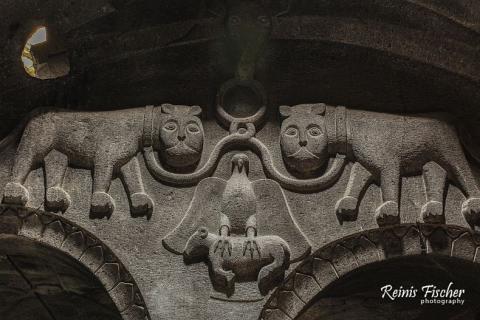Geghard is a medieval monastery in the Kotayk province of Armenia, being partially carved out of the adjacent mountain, surrounded by cliffs. It is listed as a UNESCO World Heritage Site.
I first heard about this monastery in some Travel Channel series on Armenia, I remember I was surprised when journalist told that this church is actually cut into the rock. At start of the March (2016) I visited Armenia again, and this time I decided to visit some of the most interesting tourism objects in Armenia.
My biggest discoveries during this trip to Armenia were following - Khor Virap, the Temple of Garni and Geghrard monastery - the last two are recommended to visit together, as they are located on the same route.
I really love church photography, and if you have been following my blog for a while - you have noticed I have created a separate churches and monasteries category listing my notes and photography.

Geghard monastery
From Wikipedia - While the main chapel was built in 1215, the monastery complex was founded in the 4th century by Gregory the Illuminator at the site of a sacred spring inside a cave. The monastery had thus been originally named Ayrivank, meaning "the Monastery of the Cave". The name commonly used for the monastery today, Geghard, or more fully Geghardavank, meaning "the Monastery of the Spear", originates from the spear which had wounded Jesus at the Crucifixion, allegedly brought to Armenia by Apostle Jude, called here Thaddeus, and stored amongst many other relics. Now it is displayed in the Echmiadzin treasury.

Columns in the Geghard Monastery

Rock-cut church with spring
The first cave chamber, Avazan (basin), situated north-west of the vestry, was hewn in the 1240s in an ancient cave with a spring (a place of worship in pagan times.
It is entirely dug out of the rock and has an equal-armed cruciform plan. The interior is lined by two crossed arches with a central stalactite dome. An inscription records that it was the work of the architect Galdzak, who also constructed the other rock-cut church and the jhamatuns within a period of some forty years. His name is inscribed at the base of the tent decorated with reliefs showing pomegranates.

Rock cut chained lions
Ok, I must admit at start I thought they are some cats, I was wrong thus.
The Proshyans’ sepulchre and the second cave church of Astvatsatsin situated east of Avazan, were hewn in 1283, presumably by the same Galdzak, too. These are also accessed through the gavit. The zhamatun is a roughly square chamber cut into the rock, with deeply cut reliefs in the walls. Of interest is a rather primitive high relief on the northern wall, above the archways. In the center, there is a ram's head with a chain in its jaws; the chain is wound around the necks of two lions with their heads turned to the onlooker. Instead of the tail tufts there are heads of upward looking dragons — symbolic images gong all the way back to heathen times. Between the lions and below the chain there is an eagle with half-spread wings and a lamb in its claws. This is likely the coat-of-arms of the Proshian Princes.
The reliefs of the eastern wall are no less picturesque. The entrances to a small chapel and to Astvatsatsin church have rectangular platbands connected by two relief crosses. Cut on the portals of the chapel are sirens (fantasy harpy-like birds with women's crowned heads) and on the church walls there appear human figures with their elbows bent, wearing long attires and having nimbuses around their heads. These are probably members of the princely family who had these structures built. In its floor there are burial vaults.
Something similar I first noticed at Masonic temple of Philadelphia (at least I think it was at Masonic temple)

Geghard Monastery complex
The monastery was founded in the 4th century, according to tradition by Gregory the Illuminator. The site is that of a spring arising in a cave which had been sacred in pre-Christian times, hence one of the names by which it was known, Ayrivank (the Monastery of the Cave). The first monastery was destroyed by Arabs in the 9th century.
Nothing has remained of the structures of Ayrivank. According to Armenian historians of the 4th, 8th and 10th centuries the monastery comprised, apart from religious buildings, well-appointed residential and service installations. Ayrivank suffered greatly in 923 from Nasr, a vice-regent of an Arabian caliph in Armenia, who plundered its valuable property, including unique manuscripts, and burned down the magnificent structures of the monastery. Earthquakes also did it no small damage.

Geghard monastery
